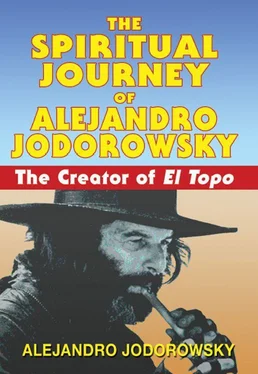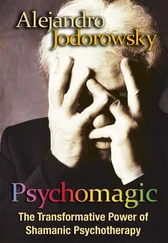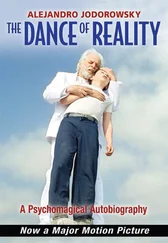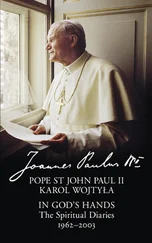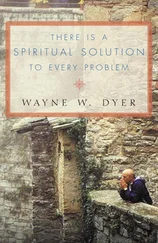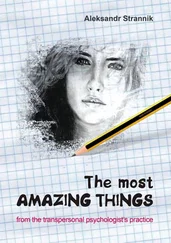Now my mind took another leap. Master and disciple are in reality symbols of an inner process: essential being and ego. Hence the host is the first and the guest the second. But I am not the owner of the house, nor am I the house itself. My reason is a simple guest, an ephemeral phantom in eternal consciousness. Before meeting Ejo, I considered my intellect to be reality. Anything that could not be put into words was untrustworthy. Thus the guest was usurping the place of the host. Having little or nothing to offer, this false host could only strut in front of himself, deaf and blind to the other. When I first sought out Ejo, I did so as a beggar, with the feeling that he was the generous guest and I was merely a thirsty, bottomless well. My demand was without limit, infinite. With mouth wide open like a baby, I wanted him to feed me without limit, for I wanted to devour the entire universe. The illusory guest of an absolute host, I lived like the seeker in the Sufi story who weeps constantly, thinking of his absolute need for God without ever imagining that God might also need him. When I had understood that the mind can never grasp itself, I realized that instead of emptying it, I should simply let it go, allowing thoughts and impressions to come and go without identifying with them. Ejo and I both were master and disciple. My ego created essential being and essential being created the ego. Finally, I realized that I was now with Ejo not because I needed to obtain something from him, but for the pleasure of being with him, vibrating at the same level of consciousness, him with his ego, me with mine, like two blind men who have learned to see but keep their guide dog — not because they need him, but out of affection for him.
A fresh wind blew away the gray fog. It shook the leaves of the trees, making a pleasant sound. From the whole forest a music arose like the vibrations of the surface of a lake agitated by shoals of fish. The birds began to sing. Even the noise of the traffic was in harmony with the whole. The world had transformed itself into an orchestra of angels. I ceased to see Ejo either as upon a heavenly summit or in the depths of the earth. He was a man like me, a clown like me, a Buddha like me.
“Ejo, it was my anguished ego that first brought me to your teaching. It is thanks to you, essential being and host, that on this day, the guest is finally a good disciple who has learned to be a mirror. He does not take anything for himself. He receives what is given without attempting to keep it. He sinks his feet in the mud but leaves no footprints.”
Happy, and grinning so that I could see the metal caps on his teeth, Ejo said: “So! And what have you decided about the kyosaku?”
“I accept it, Master. But I will not keep it. I have no desire to give blows to sleepy monks. When Bodhidharma *28sat in silent meditation before the wall of a cave for nine years, he needed no one to strike his shoulder blades. Neither did Eka, †29a man who was capable of cutting off his arm to convince Bodhidharma to accept him as a disciple. Nor did Sosan, ‡30the leprous disciple of Eka who died in meditation, standing under a tree.”
At first I thought that Ejo was angry and was about to let out a roar that would frighten me and the hundreds of birds around us. He closed his eyes and began to sway back and forth, fanning himself. Suddenly, he snapped shut his fan, opened his eyes, and exclaimed:
“You’re right! From Doshin § 31on, the wandering life came to an end. Zen became a government-sponsored religion and monasteries began to take in children. From that time on, an iron discipline was instituted. They began to strike the young ones who fell asleep meditating — but is it really that important that individuals not fall asleep during meditation? There is nothing to lose, nothing to achieve. Arriving or leaving, essential being is always there. When you eat, you eat. When you meditate, you meditate. When you sleep, you sleep. The blows of the stick offer nothing except discipline for a childish mind.
“In the Sierra Tarahumara I became ill with an inflammation of the heart muscle. My Indian disciples brought me back to the city. It seems I have to have an operation, but the real wound is to my child’s heart, and it is the real sufferer. When I was nine years old and the doors of the monastery closed upon me, the first thing I did was cry out: ‘I don’t want to stay here! Let me out!’ They put me in a dormitory where I was the youngest boy. When I failed to hear the bell ring at dawn, they kicked me awake. I had to scrub the floor while the other boys meditated. I didn’t do a very good job, and I was kicked for it. At my first breakfast of rice soup, the cook hit me with the ladle because I made noise drinking it. He also made me chew in total silence, without wasting a single grain of rice, but I couldn’t help spilling a few drops of the soup — more blows for that. Then they told me to use a hatchet to chop large pieces of wood into smaller ones. When I got splinters in my hand, they only made fun of me, calling me clumsy. At bedtime that evening, a twenty-year-old monk, the head of our group, asked me to massage him. The other boys started to giggle but stifled the sound quickly by covering their heads with the blankets. The monk told me that I was to spend the night in bed with him. ‘You will learn our customs. From now on, your job will be to soothe and relax me.’ Under the covers, he took one of my hands and placed it on his erect penis. ‘Imagine you are cleaning a carrot. Go on, do it with all your strength!’ For a whole year, I had to satisfy his whims. What could I do about it? Among monks, just as among prisoners or sailors, peoples’ sexual problems are worked out by abusing the weakest. When a new boy arrived, my torture finally came to an end. Afterward, others followed him.
“I never thought of becoming enlightened. All I wanted was to play. And I was never allowed to.”
“Ejo, I want to propose something. Let us bury this stick among the trees here, as if it were a plant. Let us imagine that someday it will sprout and produce branches, even fruit. .”
After we finished burying it, my friend gave a huge sigh. It was as if he had shed an immense burden. He burst out laughing, then he took his monk’s robe out of the net sack. “It was my master, Momon Yamanda, who gave me this kesa . *32He wove into it parts of the funeral shrouds of his father and his mother. Do you understand? We often speak of the transmission of the light, but the real master transmits the shrouds of the dead. We must see life — both our own and that of the cosmos — as an agony. This is the teaching of the Buddha Shakyamuni. After his satori, he went to the place where they incinerate corpses, and he gathered pieces of cloth left there, washed them, dyed them, and sewed them together painstakingly and slowly, giving his total attention to every stitch. That kesa was transmitted from patriarch to patriarch through the ages. Everyone who wore it while meditating was burning in body and in soul. To reach the marrow of the soul, everything superfluous must be burned to ashes. By wearing the garments of so many dead people, Buddha taught that liberation is to be obtained for them as well. When a flower opens, it is springtime for the whole land. The Buddha is like the brilliant prow of a vessel that leads it and its blind passengers to the port of salvation. I know that my way is not the same as yours, for you are more attracted to artistic creation than to meditation. But you know — there is really no difference between us. Compassion inhabits us both. Just this once, please give me the pleasure of seeing you dressed in my kesa.”
It was still so early in the morning that we were alone in the woods. I undressed slowly. Sensing an abyss before me and another behind me, I inhaled every breath of air deeply and exhaled each time as if it were my last breath. Then, feeling like a fugitive so weary of fleeing that he finally surrenders to his pursuers, I entered into the folds of the robe. Although its color was a uniform ochre, that of dry earth, it was composed of many pieces of cloth of different sizes, each connected to others with large stitches that dissolved into the form of the garment. It clung to my skin readily. I absorbed the years of meditation of Ejo, his master, and those of other masters and patriarchs all the way back to Shakyamuni Buddha himself. The sensation of my body changed, and I finally understood what it was to feel like a mountain. There was no more space or time. The voice of the first awakener resounded unceasingly: “Never pretend anything that is not certain. There is no substantial ego, no object that is not impermanent. Perceptions, feelings, and visions are processes empty of real substance. Life is suffering. Birth, illness, old age, and death are suffering. To be separated from those we love is suffering. To be forced to be with those we do not love is suffering. To be unable to satisfy our desires is suffering.”
Читать дальше
